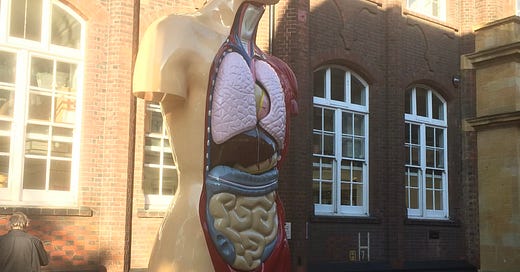In this Substack we celebrate the art and craft of Place Writing. Do you want to be inspired? Join our band of readers and writers who love everything about place and home. Subscribe now and get fortnightly posts delivered to your in-box for free.
I went to Norwich, Norfolk, to see author Ali Smith speak at the launch of her book, Autumn. On my way to Dragon Hall, I stopped in the street transfixed because, at the entrance to Norwich University’s Arts building in St George's Street, I saw a superhuman sculpture of a male torso semi-covered in ‘skin’, with underlying parts of red muscle and pink soft tissue visible. Perhaps twenty foot high, it was painted in vivid flesh tones with contrasting metalwork in gold, silver, and bronze. It was 2018, and I learned that this monumental human was called Hymn, made by contemporary artist Damien Hirst in 1999.
Memento Mori
Such three-dimensional models, skulls, and other unusual representations of the body, give us pause to stop and think about mortality. Hirst has a fascination with memento mori. He hit the headlines as a young artist with a work called The Physical Impossibility of Death in the Mind of Someone Living (1991)—a Tiger shark sealed in a case of formaldehyde. First shown at the Saatchi Gallery in 1992, it fired debate about what constitutes art and whether dead animals are proper subjects. Hirst is absorbed by death and continues to provoke controversy; a tactic that has given him airtime and, over the years, it has made him an extremely wealthy man.
A piece of art so valuable it cannot be exhibited
Hirst’s diamond-encrusted skull has an estimated value of around £50 million. After acquiring the skull of a nineteenth century man, Hirst made a platinum mould of it and then, according to instructions, a jeweller inserted the diamonds. Hirst sees the use of 8,601 stones as a way of laughing in the face of death. This smooth shiny platinum object is pockmarked by flesh-cutting shards; it’s a vision that divides opinion. Called For the Love of God (2007), it smiles with its human teeth and lays in a secure vault in Hatton Garden, London.
Over the years Hirst has influenced public taste and rarely moved away from his central theme of portraying and, some would say, beautifying death. And, of his own personal collection of objects, which includes a variety of skulls, stuffed birds, rocks, books on pathology, and much more, Hirst says, ‘They’re testament to some of my most enduring interests: the relationship between science and art, natural history, mortality and our attempts to comprehend death’.*
Back in Norwich, some university students were objecting to the positioning of Hirst’s sculpture; they thought it was an insult to display it outside their building when the cost of university fees saw them struggling financially to meet their everyday needs. While drawing attention to the difficulties that art students face, the protest unfortunately only gave Hirst more media coverage.
With thoughts about what life, and death, could hold for us, what it looks like, and how art and wealth influence us, I carried on walking to the stunningly preserved building, Dragon Hall. It was once a medieval merchants’ hall, built and paid for in the early 1400s by Robert Toppes, a man who made his money from the textile industry.
I had come to Norwich wanting to learn more about author Ali Smith, and how she managed to get her Seasons books—a series of four novels—written and traditionally published at breakneck speed. I settled into my seat and calmed myself, and contemplated on the passage of time in a place where the name and memory of a man who lived some six hundred years earlier lived on; where the sounds of merchants selling their wares were embedded in timber walls; where a new audience would shortly listen to an author speak about the books she had written, books that would entertain and influence a generation of readers; and, where down the road, a twenty foot sculpture was stopping people in their tracks.
Credits & Links
Image above is my own.
See more about Dragon Hall, Norwich.
See For the Love of God (2007). And Hymn (1999).
Article in Art21 Magazine by Julia Steinmetz. For the Love of God: The Artist as Capitalist.
*quote appeared on Christies.com but is no longer accessible.
As always, I look forward to chatting in the comments!
Yasmin





Reading about this sculpture, I was immediately struck by the linguistic similarities between the words 'hymn' and 'human'. The etymology reveals no links between the two, but for me, they are inextricably linked. 💜
What a provocative piece of sculpture! What a scene vividly drawn for an author reading.